Economics Assignment 1: Analysis of Elasticity and Economic Policies
VerifiedAdded on 2020/05/04
|6
|988
|170
Homework Assignment
AI Summary
This economics assignment analyzes the concept of own price elasticity in relation to different food categories, highlighting the inelastic demand for unhealthy foods and the potential impact of government interventions like taxes and subsidies. The assignment also delves into Keynesian economics, discussing the role of expansionary monetary and fiscal policies in stimulating demand during economic downturns. It examines the effects of recession, fiscal contraction, and the significance of monetary policy in controlling inflation and stimulating economic activity. The paper provides a detailed understanding of how fiscal and monetary tools can be used to manage the economy, including government spending, taxation, and interest rate adjustments, with references to relevant economic literature.
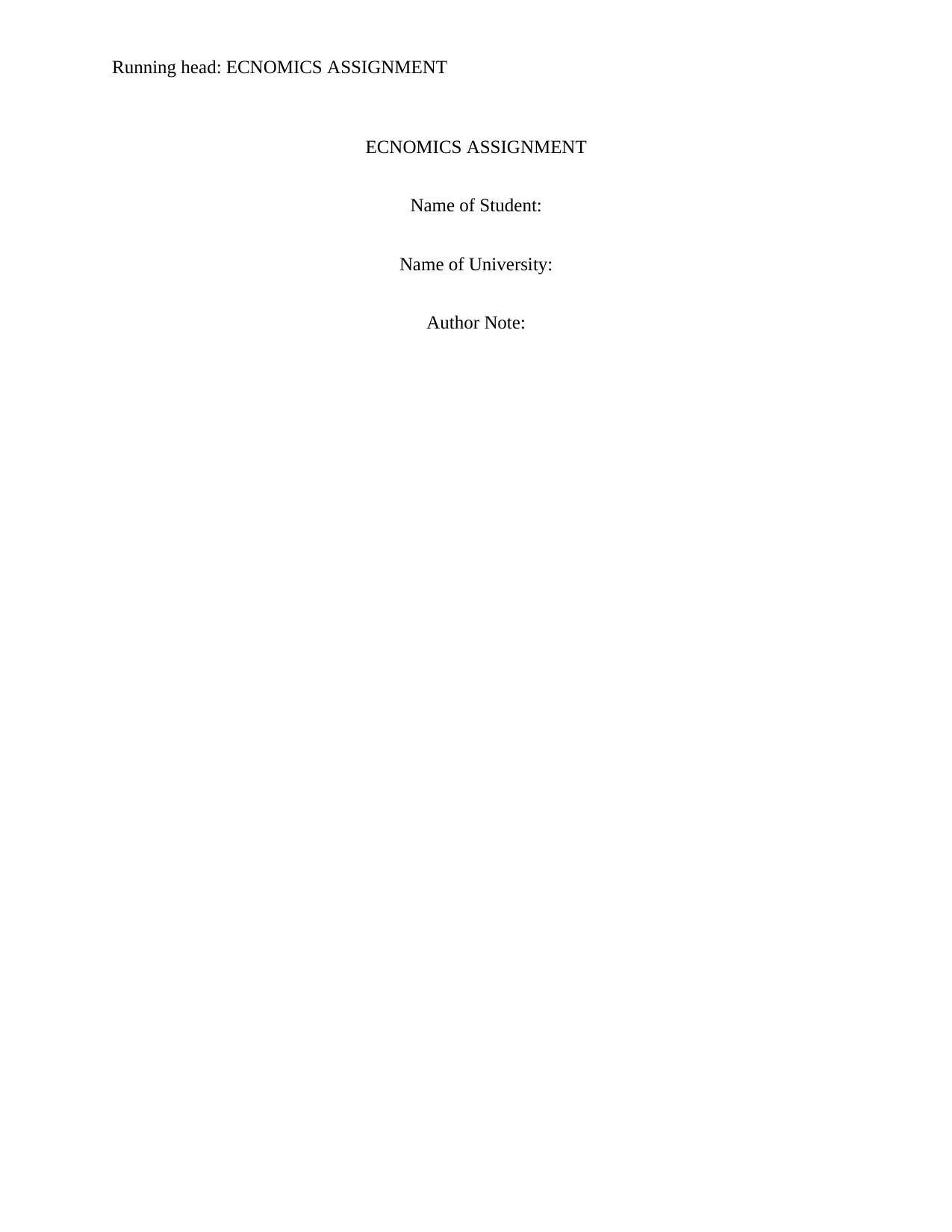
Running head: ECNOMICS ASSIGNMENT
ECNOMICS ASSIGNMENT
Name of Student:
Name of University:
Author Note:
ECNOMICS ASSIGNMENT
Name of Student:
Name of University:
Author Note:
Paraphrase This Document
Need a fresh take? Get an instant paraphrase of this document with our AI Paraphraser
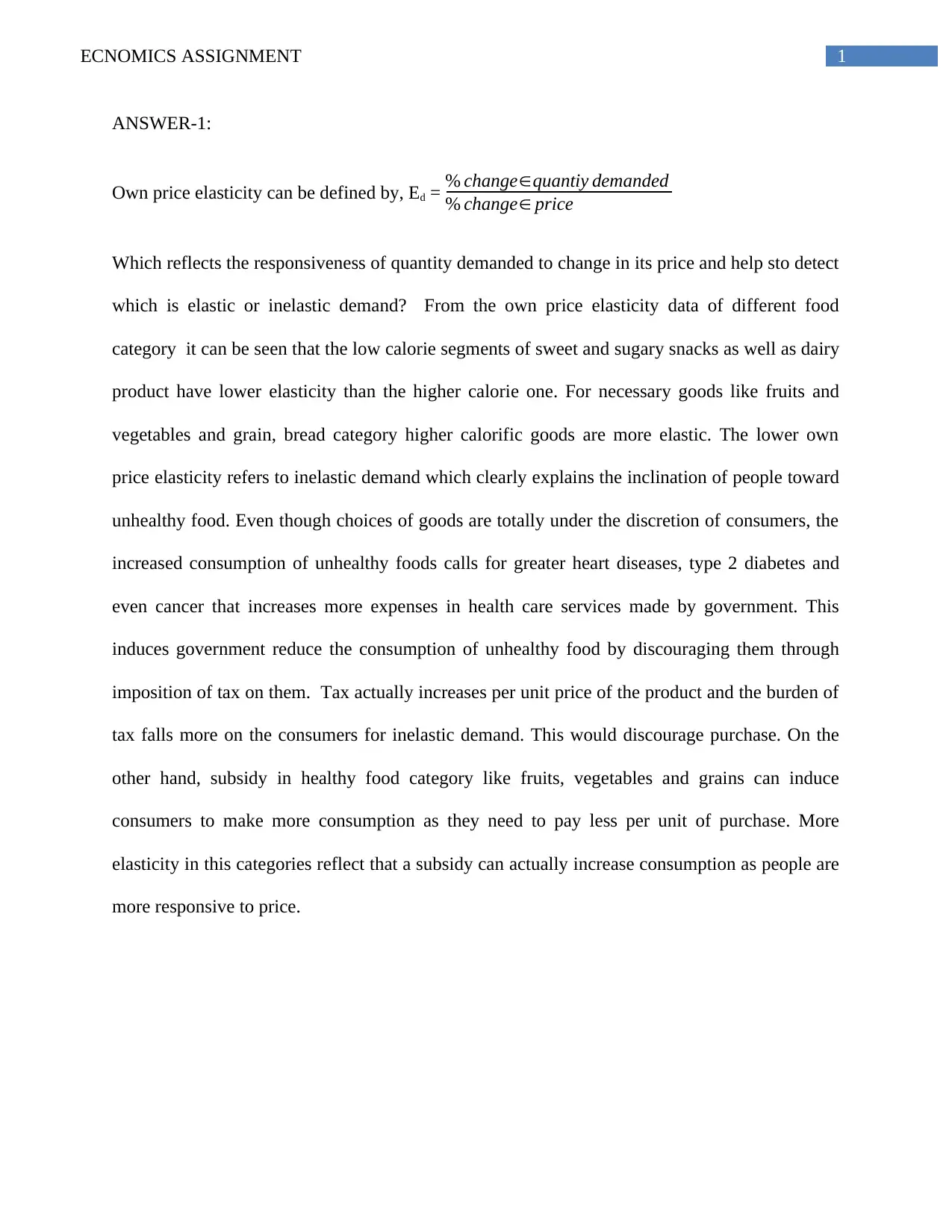
1ECNOMICS ASSIGNMENT
ANSWER-1:
Own price elasticity can be defined by, Ed = % change∈quantiy demanded
% change∈ price
Which reflects the responsiveness of quantity demanded to change in its price and help sto detect
which is elastic or inelastic demand? From the own price elasticity data of different food
category it can be seen that the low calorie segments of sweet and sugary snacks as well as dairy
product have lower elasticity than the higher calorie one. For necessary goods like fruits and
vegetables and grain, bread category higher calorific goods are more elastic. The lower own
price elasticity refers to inelastic demand which clearly explains the inclination of people toward
unhealthy food. Even though choices of goods are totally under the discretion of consumers, the
increased consumption of unhealthy foods calls for greater heart diseases, type 2 diabetes and
even cancer that increases more expenses in health care services made by government. This
induces government reduce the consumption of unhealthy food by discouraging them through
imposition of tax on them. Tax actually increases per unit price of the product and the burden of
tax falls more on the consumers for inelastic demand. This would discourage purchase. On the
other hand, subsidy in healthy food category like fruits, vegetables and grains can induce
consumers to make more consumption as they need to pay less per unit of purchase. More
elasticity in this categories reflect that a subsidy can actually increase consumption as people are
more responsive to price.
ANSWER-1:
Own price elasticity can be defined by, Ed = % change∈quantiy demanded
% change∈ price
Which reflects the responsiveness of quantity demanded to change in its price and help sto detect
which is elastic or inelastic demand? From the own price elasticity data of different food
category it can be seen that the low calorie segments of sweet and sugary snacks as well as dairy
product have lower elasticity than the higher calorie one. For necessary goods like fruits and
vegetables and grain, bread category higher calorific goods are more elastic. The lower own
price elasticity refers to inelastic demand which clearly explains the inclination of people toward
unhealthy food. Even though choices of goods are totally under the discretion of consumers, the
increased consumption of unhealthy foods calls for greater heart diseases, type 2 diabetes and
even cancer that increases more expenses in health care services made by government. This
induces government reduce the consumption of unhealthy food by discouraging them through
imposition of tax on them. Tax actually increases per unit price of the product and the burden of
tax falls more on the consumers for inelastic demand. This would discourage purchase. On the
other hand, subsidy in healthy food category like fruits, vegetables and grains can induce
consumers to make more consumption as they need to pay less per unit of purchase. More
elasticity in this categories reflect that a subsidy can actually increase consumption as people are
more responsive to price.
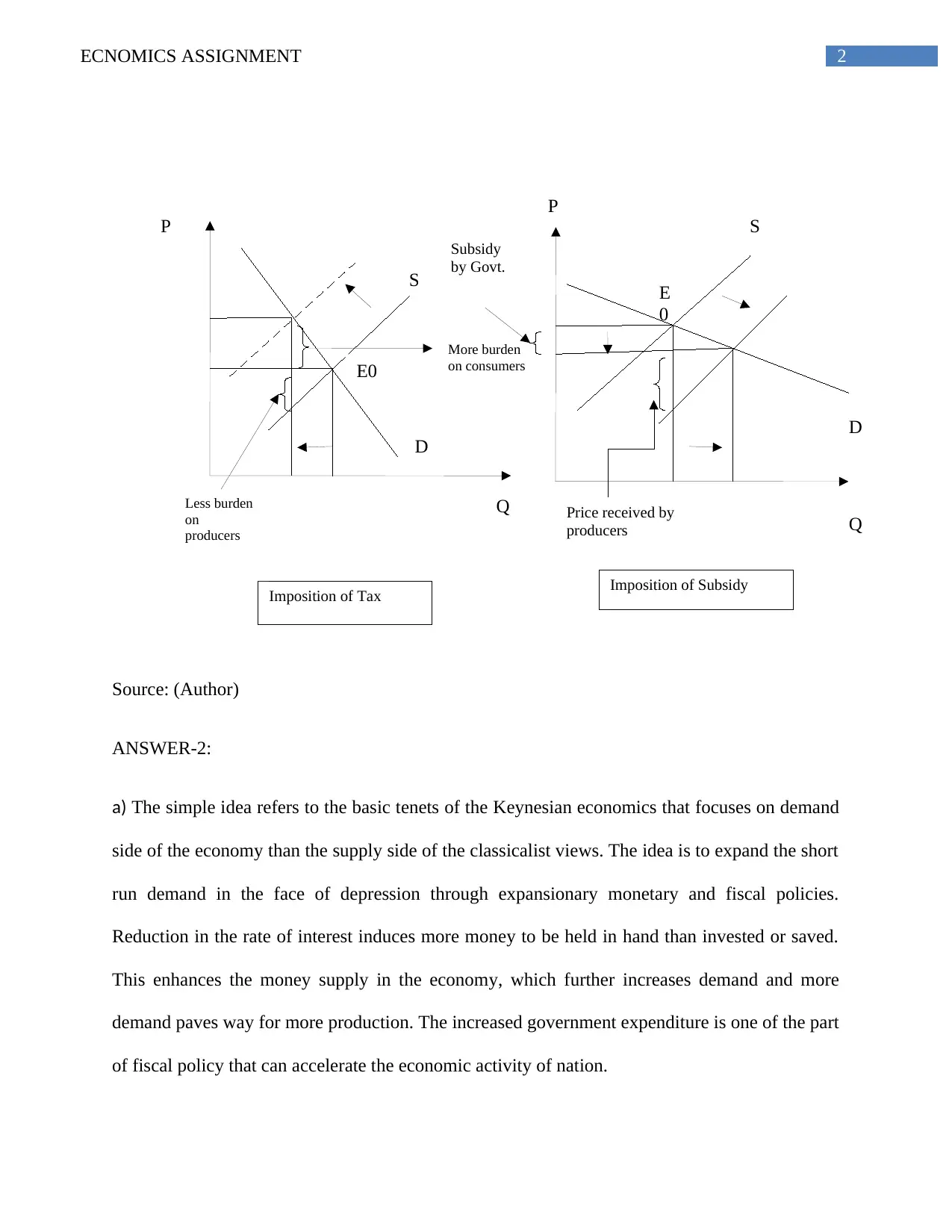
2ECNOMICS ASSIGNMENT
More burden
on consumers
Price received by
producers
Subsidy
by Govt.
P
Q Q
P
E
0
E0
S
D
D
S
Imposition of Subsidy
Imposition of Tax
Less burden
on
producers
Source: (Author)
ANSWER-2:
a) The simple idea refers to the basic tenets of the Keynesian economics that focuses on demand
side of the economy than the supply side of the classicalist views. The idea is to expand the short
run demand in the face of depression through expansionary monetary and fiscal policies.
Reduction in the rate of interest induces more money to be held in hand than invested or saved.
This enhances the money supply in the economy, which further increases demand and more
demand paves way for more production. The increased government expenditure is one of the part
of fiscal policy that can accelerate the economic activity of nation.
More burden
on consumers
Price received by
producers
Subsidy
by Govt.
P
Q Q
P
E
0
E0
S
D
D
S
Imposition of Subsidy
Imposition of Tax
Less burden
on
producers
Source: (Author)
ANSWER-2:
a) The simple idea refers to the basic tenets of the Keynesian economics that focuses on demand
side of the economy than the supply side of the classicalist views. The idea is to expand the short
run demand in the face of depression through expansionary monetary and fiscal policies.
Reduction in the rate of interest induces more money to be held in hand than invested or saved.
This enhances the money supply in the economy, which further increases demand and more
demand paves way for more production. The increased government expenditure is one of the part
of fiscal policy that can accelerate the economic activity of nation.
⊘ This is a preview!⊘
Do you want full access?
Subscribe today to unlock all pages.

Trusted by 1+ million students worldwide
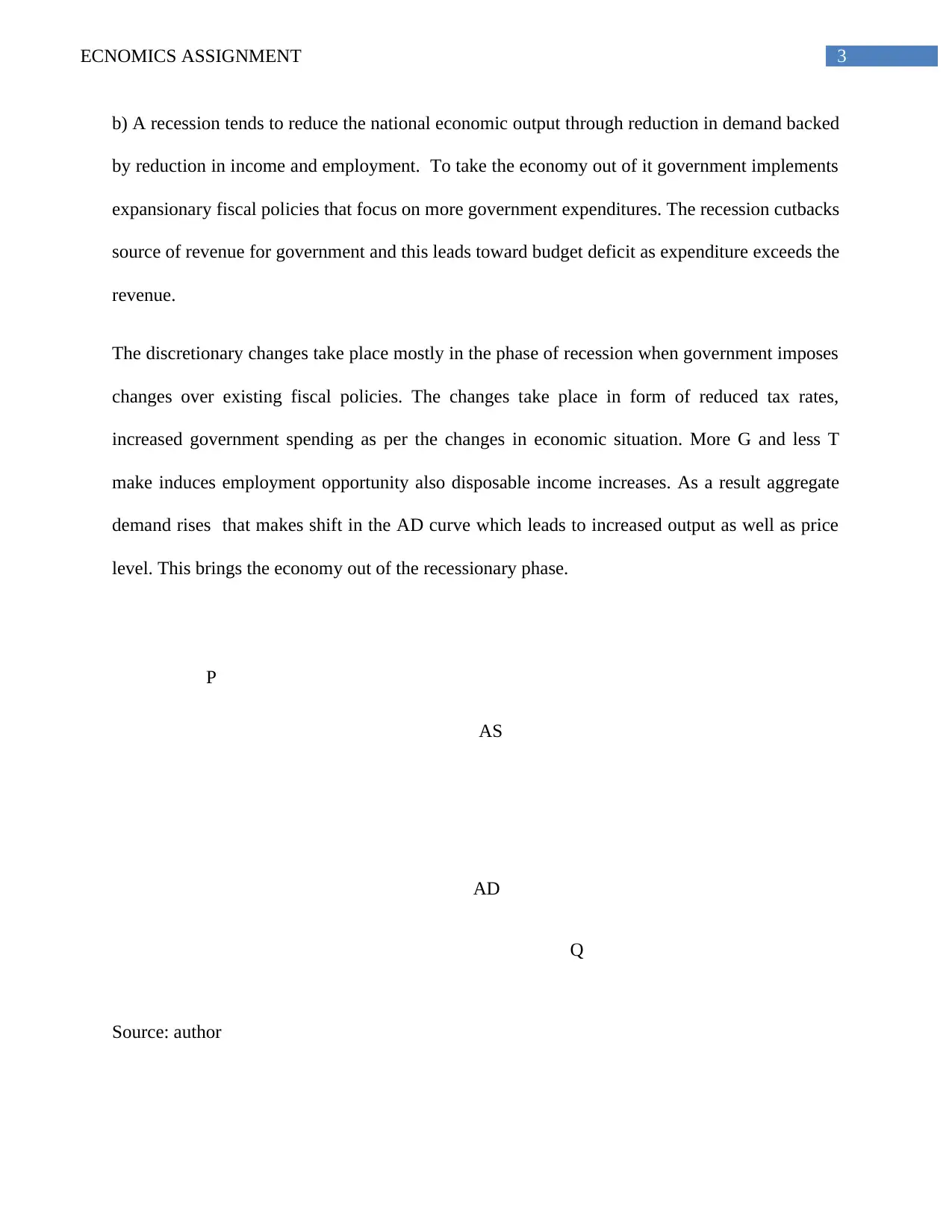
3ECNOMICS ASSIGNMENT
P
Q
AD
AS
b) A recession tends to reduce the national economic output through reduction in demand backed
by reduction in income and employment. To take the economy out of it government implements
expansionary fiscal policies that focus on more government expenditures. The recession cutbacks
source of revenue for government and this leads toward budget deficit as expenditure exceeds the
revenue.
The discretionary changes take place mostly in the phase of recession when government imposes
changes over existing fiscal policies. The changes take place in form of reduced tax rates,
increased government spending as per the changes in economic situation. More G and less T
make induces employment opportunity also disposable income increases. As a result aggregate
demand rises that makes shift in the AD curve which leads to increased output as well as price
level. This brings the economy out of the recessionary phase.
Source: author
P
Q
AD
AS
b) A recession tends to reduce the national economic output through reduction in demand backed
by reduction in income and employment. To take the economy out of it government implements
expansionary fiscal policies that focus on more government expenditures. The recession cutbacks
source of revenue for government and this leads toward budget deficit as expenditure exceeds the
revenue.
The discretionary changes take place mostly in the phase of recession when government imposes
changes over existing fiscal policies. The changes take place in form of reduced tax rates,
increased government spending as per the changes in economic situation. More G and less T
make induces employment opportunity also disposable income increases. As a result aggregate
demand rises that makes shift in the AD curve which leads to increased output as well as price
level. This brings the economy out of the recessionary phase.
Source: author
Paraphrase This Document
Need a fresh take? Get an instant paraphrase of this document with our AI Paraphraser
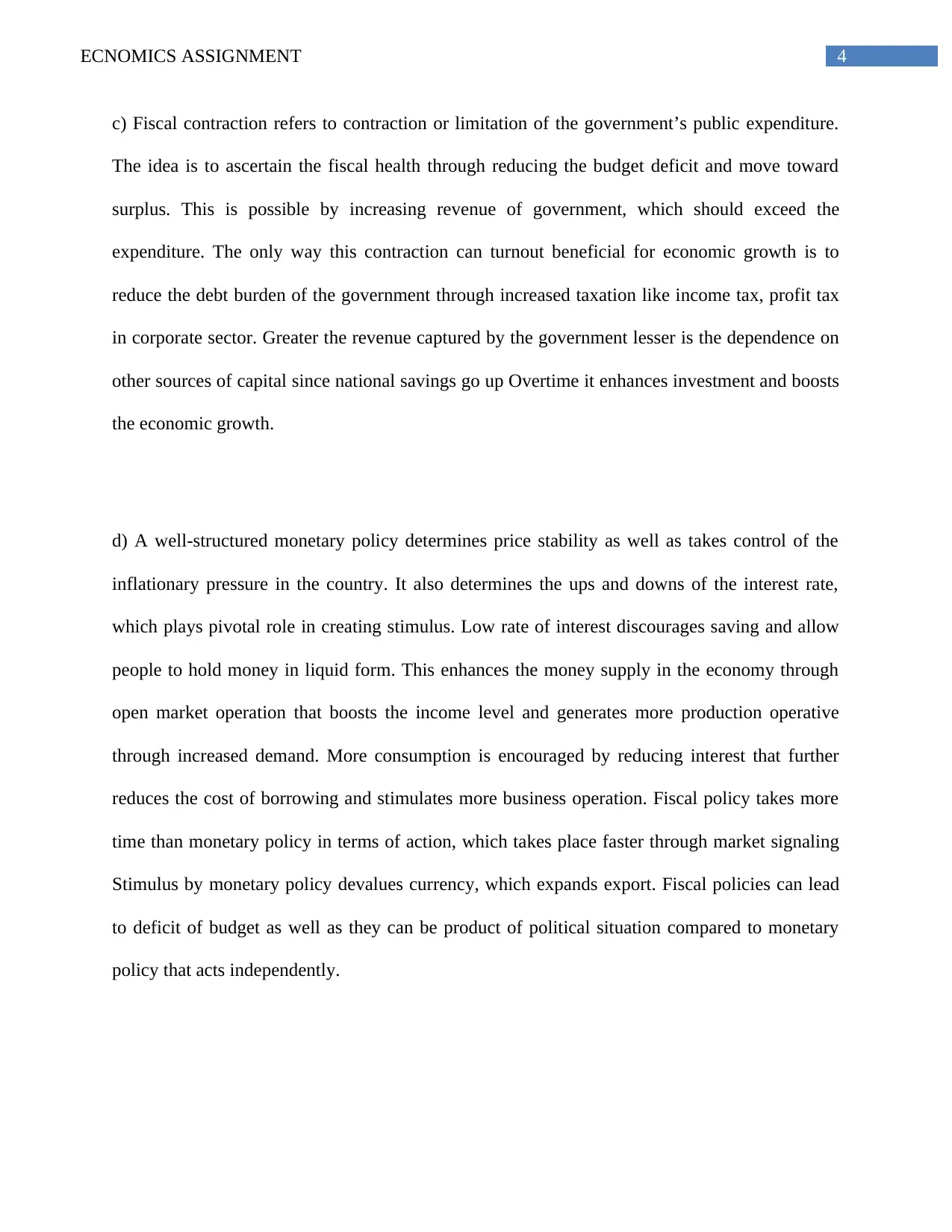
4ECNOMICS ASSIGNMENT
c) Fiscal contraction refers to contraction or limitation of the government’s public expenditure.
The idea is to ascertain the fiscal health through reducing the budget deficit and move toward
surplus. This is possible by increasing revenue of government, which should exceed the
expenditure. The only way this contraction can turnout beneficial for economic growth is to
reduce the debt burden of the government through increased taxation like income tax, profit tax
in corporate sector. Greater the revenue captured by the government lesser is the dependence on
other sources of capital since national savings go up Overtime it enhances investment and boosts
the economic growth.
d) A well-structured monetary policy determines price stability as well as takes control of the
inflationary pressure in the country. It also determines the ups and downs of the interest rate,
which plays pivotal role in creating stimulus. Low rate of interest discourages saving and allow
people to hold money in liquid form. This enhances the money supply in the economy through
open market operation that boosts the income level and generates more production operative
through increased demand. More consumption is encouraged by reducing interest that further
reduces the cost of borrowing and stimulates more business operation. Fiscal policy takes more
time than monetary policy in terms of action, which takes place faster through market signaling
Stimulus by monetary policy devalues currency, which expands export. Fiscal policies can lead
to deficit of budget as well as they can be product of political situation compared to monetary
policy that acts independently.
c) Fiscal contraction refers to contraction or limitation of the government’s public expenditure.
The idea is to ascertain the fiscal health through reducing the budget deficit and move toward
surplus. This is possible by increasing revenue of government, which should exceed the
expenditure. The only way this contraction can turnout beneficial for economic growth is to
reduce the debt burden of the government through increased taxation like income tax, profit tax
in corporate sector. Greater the revenue captured by the government lesser is the dependence on
other sources of capital since national savings go up Overtime it enhances investment and boosts
the economic growth.
d) A well-structured monetary policy determines price stability as well as takes control of the
inflationary pressure in the country. It also determines the ups and downs of the interest rate,
which plays pivotal role in creating stimulus. Low rate of interest discourages saving and allow
people to hold money in liquid form. This enhances the money supply in the economy through
open market operation that boosts the income level and generates more production operative
through increased demand. More consumption is encouraged by reducing interest that further
reduces the cost of borrowing and stimulates more business operation. Fiscal policy takes more
time than monetary policy in terms of action, which takes place faster through market signaling
Stimulus by monetary policy devalues currency, which expands export. Fiscal policies can lead
to deficit of budget as well as they can be product of political situation compared to monetary
policy that acts independently.
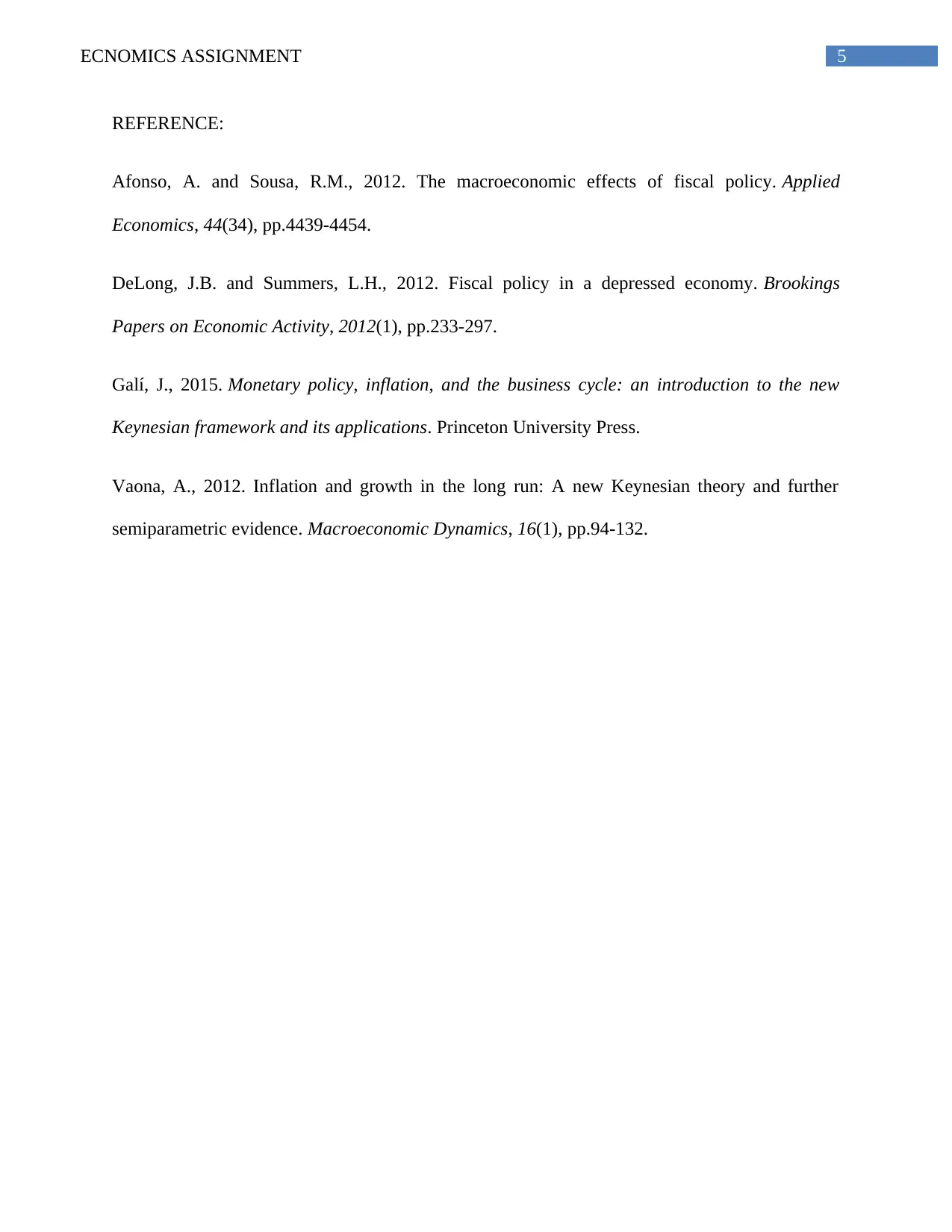
5ECNOMICS ASSIGNMENT
REFERENCE:
Afonso, A. and Sousa, R.M., 2012. The macroeconomic effects of fiscal policy. Applied
Economics, 44(34), pp.4439-4454.
DeLong, J.B. and Summers, L.H., 2012. Fiscal policy in a depressed economy. Brookings
Papers on Economic Activity, 2012(1), pp.233-297.
Galí, J., 2015. Monetary policy, inflation, and the business cycle: an introduction to the new
Keynesian framework and its applications. Princeton University Press.
Vaona, A., 2012. Inflation and growth in the long run: A new Keynesian theory and further
semiparametric evidence. Macroeconomic Dynamics, 16(1), pp.94-132.
REFERENCE:
Afonso, A. and Sousa, R.M., 2012. The macroeconomic effects of fiscal policy. Applied
Economics, 44(34), pp.4439-4454.
DeLong, J.B. and Summers, L.H., 2012. Fiscal policy in a depressed economy. Brookings
Papers on Economic Activity, 2012(1), pp.233-297.
Galí, J., 2015. Monetary policy, inflation, and the business cycle: an introduction to the new
Keynesian framework and its applications. Princeton University Press.
Vaona, A., 2012. Inflation and growth in the long run: A new Keynesian theory and further
semiparametric evidence. Macroeconomic Dynamics, 16(1), pp.94-132.
⊘ This is a preview!⊘
Do you want full access?
Subscribe today to unlock all pages.

Trusted by 1+ million students worldwide
1 out of 6
Related Documents
Your All-in-One AI-Powered Toolkit for Academic Success.
+13062052269
info@desklib.com
Available 24*7 on WhatsApp / Email
![[object Object]](/_next/static/media/star-bottom.7253800d.svg)
Unlock your academic potential
Copyright © 2020–2025 A2Z Services. All Rights Reserved. Developed and managed by ZUCOL.





